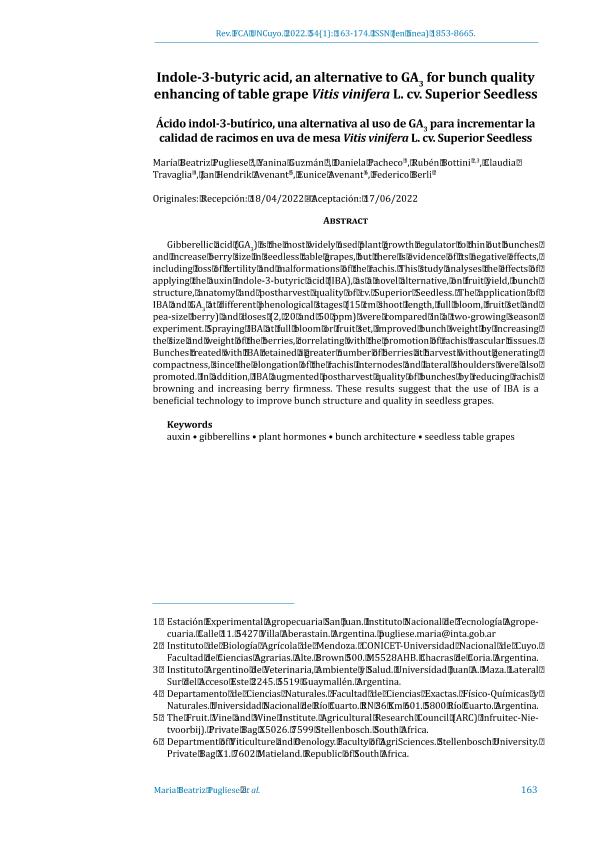Artículo
Gibberellic acid (GA3) is the most widely used plant growth regulator to thin out bunches and increase berry size in seedless table grapes, but there is evidence of its negative effects, including loss of fertility and malformations of the rachis. This study analyses the effects of applying the auxin indole-3-butyric acid (IBA), as a novel alternative, on fruit yield, bunch structure, anatomy and postharvest quality of cv. Superior Seedless. The application of IBA and GA3 at different phenological stages (15 cm shoot length, full bloom, fruit set and pea-size berry) and doses (2, 20 and 50 ppm) were compared in a two-growing season experiment. Spraying IBA at full bloom or fruit set, improved bunch weight by increasing the size and weight of the berries, correlating with the promotion of rachis vascular tissues. Bunches treated with IBA retained a greater number of berries at harvest without generating compactness, since the elongation of the rachis internodes and lateral shoulders were also promoted. In addition, IBA augmented postharvest quality of bunches by reducing rachis browning and increasing berry firmness. These results suggest that the use of IBA is a beneficial technology to improve bunch structure and quality in seedless grapes. El ácido giberélico (GA3 ) es el regulador de crecimiento vegetal más utilizado para ralear flores en racimos y aumentar el tamaño de las bayas en uvas de mesa sin semilla, pero hay evidencia de efectos negativos por su uso, incluyendo pérdida de fertilidad y malformaciones del raquis. En este estudio se analizan los efectos de aplicar la auxina ácida indol-3- butírico (IBA), como alternativa novedosa, sobre el rendimiento de frutos, estructura del racimo, anatomía y calidad poscosecha del cv. Superior Seedless. Se comparó la aplicación de IBA y GA3 en diferentes estadios fenológicos (brote de 15 cm, floración plena, cuaje y baya grano arveja) y dosis (2, 20 y 50 ppm), en un experimento de dos temporadas de cultivo. La aspersión de IBA en floración plena o en cuaje mejoró el peso del racimo al aumentar el tamaño y el peso de las bayas, correlacionándose con la promoción de los tejidos vasculares del raquis. Los racimos tratados con IBA retuvieron un mayor número de bayas a cosecha sin generar compacidad, ya que también se favoreció el alargamiento de los entrenudos del raquis y la longitud de los laterales. Además, IBA aumentó la calidad poscosecha de los racimos al reducir el oscurecimiento del raquis y aumentar la firmeza de la baya. Estos resultados sugieren que el uso de IBA es una tecnología beneficiosa para mejorar la estructura y calidad de los racimos en uvas sin semillas.
Indole-3-butyric acid, an alternative to GA3 for bunch quality enhancing of table grape Vitis vinifera L. cv. Superior Seedless
Título:
Ácido indol-3-butírico, una alternativa al uso de GA3 para incrementar la calidad de racimos en uva de mesa Vitis vinifera L. cv. Superior Seedless
Pugliese, Maria Beatriz; Guzmán, Yanina; Pacheco, Daniela Elizabeth; Bottini, Ambrosio Ruben ; Travaglia, Claudia Noemi
; Travaglia, Claudia Noemi ; Avenant, Jan Hendrik; Avenant, Eunice; Berli, Federico Javier
; Avenant, Jan Hendrik; Avenant, Eunice; Berli, Federico Javier
 ; Travaglia, Claudia Noemi
; Travaglia, Claudia Noemi ; Avenant, Jan Hendrik; Avenant, Eunice; Berli, Federico Javier
; Avenant, Jan Hendrik; Avenant, Eunice; Berli, Federico Javier
Fecha de publicación:
01/2022
Editorial:
Universidad Nacional de Cuyo
Revista:
Revista de la Facultad de Ciencias Agrarias de la Universidad Nacional de Cuyo
ISSN:
1853-8665
Idioma:
Español
Tipo de recurso:
Artículo publicado
Clasificación temática:
Resumen
Palabras clave:
AUXIN
,
BUNCH ARCHITECTURE
,
GIBBERELLINS
,
PLANT HORMONES
,
SEEDLESS TABLE GRAPES
Archivos asociados
Licencia
Identificadores
Colecciones
Articulos (INIAB)
Articulos de INSTITUTO DE INVESTIGACIONES AGROBIOTECNOLOGICAS
Articulos de INSTITUTO DE INVESTIGACIONES AGROBIOTECNOLOGICAS
Articulos(IBAM)
Articulos de INST.DE BIOLOGIA AGRICOLA DE MENDOZA
Articulos de INST.DE BIOLOGIA AGRICOLA DE MENDOZA
Citación
Pugliese, Maria Beatriz; Guzmán, Yanina; Pacheco, Daniela Elizabeth; Bottini, Ambrosio Ruben; Travaglia, Claudia Noemi; et al.; Indole-3-butyric acid, an alternative to GA3 for bunch quality enhancing of table grape Vitis vinifera L. cv. Superior Seedless; Universidad Nacional de Cuyo; Revista de la Facultad de Ciencias Agrarias de la Universidad Nacional de Cuyo; 54; 1; 1-2022; 163-174
Compartir
Altmétricas



